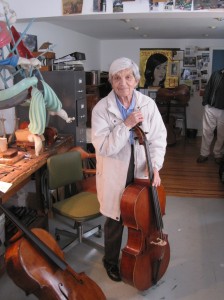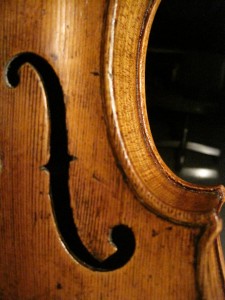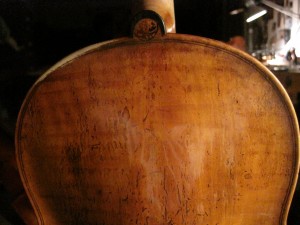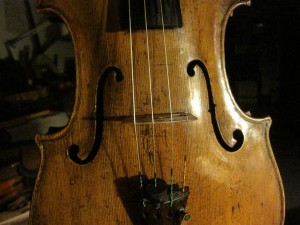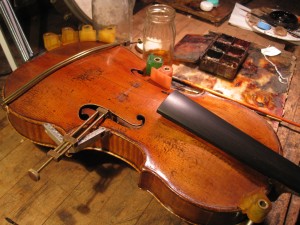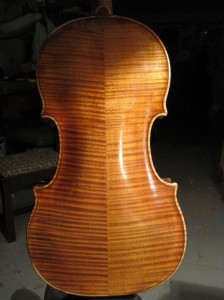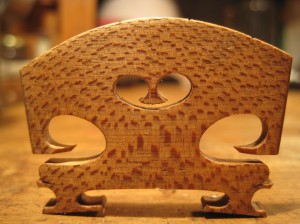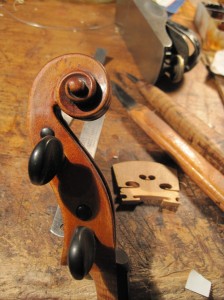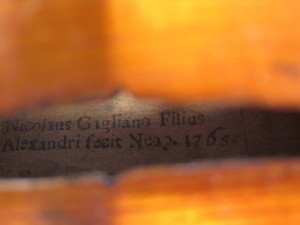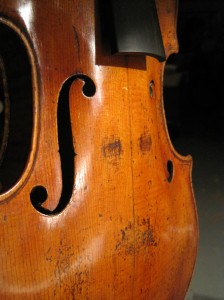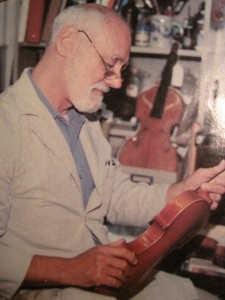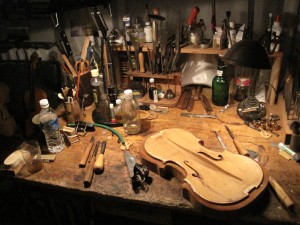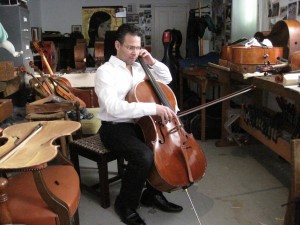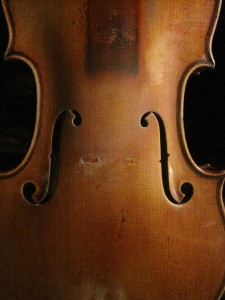 This beautiful, charming violin has come to me for ,among other things, a new fingerboard. It was made by a little known maker who was born in 1905, worked in Ravenna an
This beautiful, charming violin has come to me for ,among other things, a new fingerboard. It was made by a little known maker who was born in 1905, worked in Ravenna an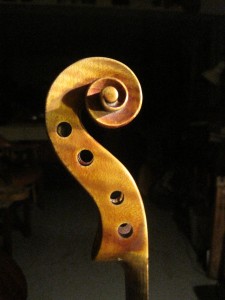 d was the pupil of the maker Domenico Veggi. There is so much to like about this fiddle. The bold S curve of the scroll. The artful, unfussy fluting of the lower tabs of the F-holes. The beautiful back with its lovely,soft, transparent orange varnish, handsome wood and stylish outline make this violin a treat to have on my bench
d was the pupil of the maker Domenico Veggi. There is so much to like about this fiddle. The bold S curve of the scroll. The artful, unfussy fluting of the lower tabs of the F-holes. The beautiful back with its lovely,soft, transparent orange varnish, handsome wood and stylish outline make this violin a treat to have on my bench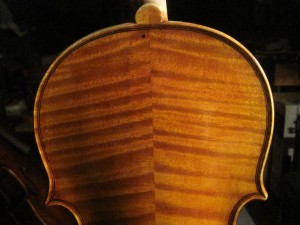 . This violin has everything that I find is so special about Italian violinmaking- (and its even magically present in a maker that you don’t know)- You feel the human hand, the beating heart and that artistic leap where spirit animates the labored object.
. This violin has everything that I find is so special about Italian violinmaking- (and its even magically present in a maker that you don’t know)- You feel the human hand, the beating heart and that artistic leap where spirit animates the labored object.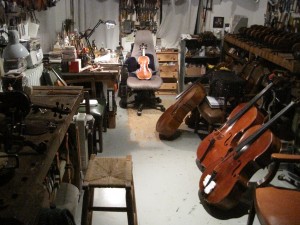 Finally, a shot of it surrounded by so many other inspiring instruments – I’m truly a lucky man to be immersed, through my late nights, with such things
Finally, a shot of it surrounded by so many other inspiring instruments – I’m truly a lucky man to be immersed, through my late nights, with such things
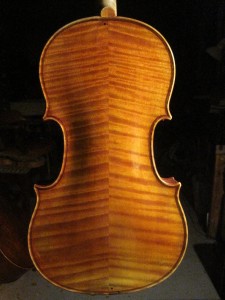
The Grande Dame of the cello world- Metta Watts
“Billie” Watts was Orlando Cole”s assistant for decades. Together they were a dramatic force shaping many of the most talented cellists of our day. She continues to be a tremendous teacher and influence on countless young musicians.Her energy and passion are an inspiration to me as I’m sure they are to her many students. I’m proud to build on our long association at Wm Moennig & Son and continue to work on her cellos and also her student’s cellos in my own shop. Whether bringing out the best in a cello, solving a problem or helping a student find a cello at the next level, I will constantly work to continue to earn that trust.
One vivid memory of the last day that Moennig”s was open: Billie came in to say goodbye and while reminiscing thought back to when she first set foot in the shop to buy her first cello and said very matter- of- factly that it was “over 70 years ago”. That said it all
A beautiful,rugged viola by C.A Testore 1756
This great viola is part of the world famous string sound of the Philadelphia Orchestra. It made the arduous trek with the Orchestra on their recent tour in China and the far east and now needs some careful gluings ,varnish attention and a thorough going over to make sure all is well. This instrument has all the charm and style you look for in Carlo’s work The distinctive small,meager turns of the scroll and the narrowing peg box give real personality.On the back Carlo dresses up the plain maple with hand painted flames and saves time in the making by scratching on the purfling and you can see the remains his brand which depict the initials C A T in an eagle design that was the pattern of the sign in front of his shop in Milan of the second half of the 18th century 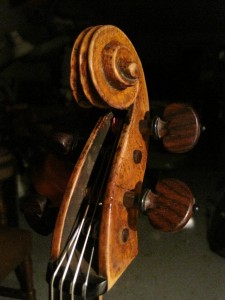 The bold, openly cut F-hole shows him working rather quickly and the photo hints at the strong,robust arching that gives this viola such power . Also evident is the tight grained spruce with the typical clear, yellowish varnish for which the Testore family are justly renowned for. Taken all together it is a wonderful example of bold instrument making, made efficiently for working musicians by artistic hands with personal and local style with ,above all , real life in its grain
The bold, openly cut F-hole shows him working rather quickly and the photo hints at the strong,robust arching that gives this viola such power . Also evident is the tight grained spruce with the typical clear, yellowish varnish for which the Testore family are justly renowned for. Taken all together it is a wonderful example of bold instrument making, made efficiently for working musicians by artistic hands with personal and local style with ,above all , real life in its grain
Powerful 17″ Moennig Jr viola
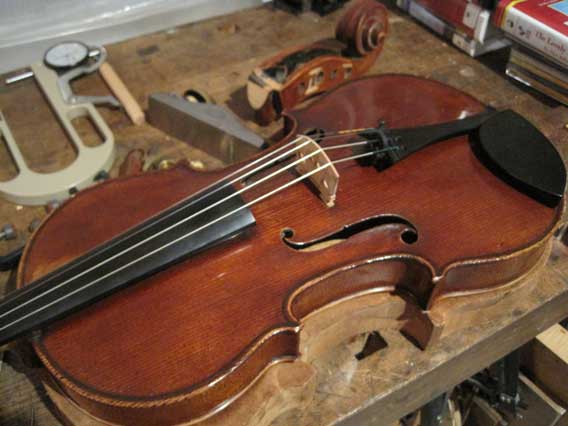
[nggallery id=3]
A big,beautiful William Moennig Jr. viola dating from 1943. Made originally for Samuel Lifschey,principal violist of the Philadelphia Orchestra, it is now now in the hands of a talented young player who brings out all its color and resonance. Although not easy to play physically it produces a depth in the lower register that,once you get used to, you can’t live without.
An interesting autographed photo of William Moennig Jr accompanies the photos of the viola. It is a photo taken on Dec 17th 1955 backstage at the Academy of Music after a performance by the famed violinist David Oistrakh. In the photograph Mr Oistrakh is shown in the mirror of his dressing room signing autographs,whlie Bill Jr in the foreground holds up the Strad he used for both the concert and in his recording of the Brahms violin concerto. In the mirror are also some burly men that were part of a KGB detail that followed Mr Oistrakh around the states to keep him from defecting during that tense Cold War time. Mr Oistrakh’s words translate to: “To an oustanding violin maker and an excellent gentleman,William Moennig- with respect and best wishes, David Oistrakh.”
Irv Ludwig
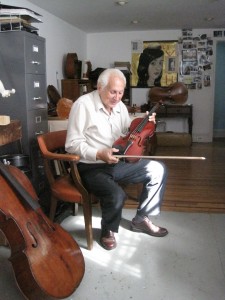 Irv Ludwig -member of the Philadelphia Orchestra for decades and conductor of the Lansdowne Symphony stops by to play through the collection looking for a suitable fiddle for a student. In this image he is enjoying getting to know a violin by H Blaise made in Mirecourt,France c 1920. He is always great to have in the studio – a wonderful raconteur with a long view of time. He is the father of another long term client, Michael Ludwig (both going back to the Moennig days) who was also once of the Philly O – but now concertmaster of the Buffalo Symphony
Irv Ludwig -member of the Philadelphia Orchestra for decades and conductor of the Lansdowne Symphony stops by to play through the collection looking for a suitable fiddle for a student. In this image he is enjoying getting to know a violin by H Blaise made in Mirecourt,France c 1920. He is always great to have in the studio – a wonderful raconteur with a long view of time. He is the father of another long term client, Michael Ludwig (both going back to the Moennig days) who was also once of the Philly O – but now concertmaster of the Buffalo Symphony
Beautiful Nicolo Gagliano 1765
This beautiful Nicolo Gagliano is played by the concertmaster of the Little Rock Symphony. Nicolo, son of Alessandro, is the greatest maker of the Neapolitan school and this violin displays his art in all its power.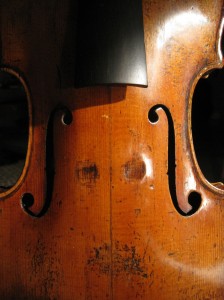 It has the broad model, upright F-holes, great wood and stunning varnish that typify this maker. The scroll is very distinctive with its small head and wide ears that are characteristic of the Neopolitan school. The violin is slightly short with a short stop length but it makes up for it with strong, full arching and broad design. Drew is very fussy about this vioin and its with me now for gluings, cleaning and varnish restoration along with a new bridge. Always a great fiddle to have on your bench
It has the broad model, upright F-holes, great wood and stunning varnish that typify this maker. The scroll is very distinctive with its small head and wide ears that are characteristic of the Neopolitan school. The violin is slightly short with a short stop length but it makes up for it with strong, full arching and broad design. Drew is very fussy about this vioin and its with me now for gluings, cleaning and varnish restoration along with a new bridge. Always a great fiddle to have on your bench
Lorenzo Storioni 1790’s
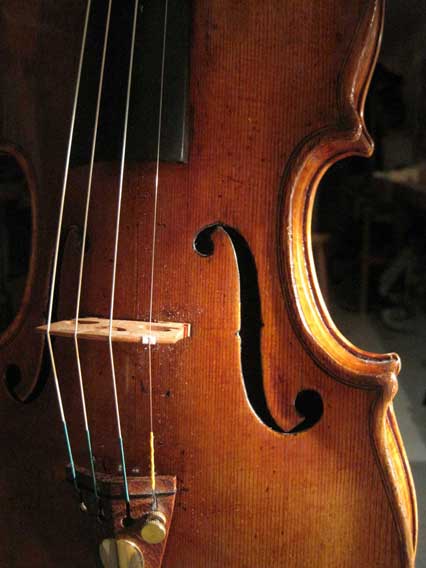
[nggallery id=4]
This wonderful violin made by Lorenzo Storioni is played by the Concertmaster of the Buffalo Philharmonic. It has great rugged charm and all the beauty of 18th century Cremona violinmaking. Storioni doesn’t possess the elegant wood and refined workmanship of his predecessors like Stradivari and Guarneri but he accomplishes quite a lot with what he has. This instrument has bold F-holes,a daring scroll and pretty varnish over wood with loads of character. This instrument gets frequent attention given its busy orchestra and soloist schedule and the high standard that it must meet in all kinds of climates.Careful attention to the photo of the scroll will show that the pegbox is not original. There is a faint seam just beyond the pegbox that shows where the original scroll ends and the repair starts
My Mentor
I had the good fortune to be the last apprentice taken on by William Moennig III. Over the sixteen years that I worked for him and with him he was very consistent. He was tough, demanding and uncompromising,which is everything you want a mentor to be.His ability to take the long view with an apprentice grew out of a deep sense of time and perspective that came with being the head of a 100 year old family business and a legacy of violin making that stretched back 12 generations. Not only was Bill the head of a prestigious shop, he had studied with the leading European masters of his day. He often told fond, interesting stories of his training in Mirecourt, France with Amadee Dieudonne ,(where he was a bench mate with Rene Morel),and time spent learning and working with Aschauer in Mittenwald, Vidoudez in Switzerland and Moller in Holland.He was a man of stature that you did not want to let down.
Bill was,deep down, an artistic person and I think he responded to my training and interest in art. He had a great ability to take a chance on a person:sink or swim. You progressed under the watchful and helpful eyes of everyone in the shop and you quickly learned not to let anything leave your bench that you were not not completely satisfied with.I gauged my progress by the instruments I was handed. As your skills evolved you were handed ever finer instruments until one day, many years later, you were handed a fine instrument that needed major work and then you knew.
I am most grateful to Bill for his long,patient stewardship through those years. Though the progress came from my own hard work, his guidance and example put me on a path that I am still on today. Now as I merge my skills and craftsmanship with the running of a business I am increasingly grateful for the opportunity that I had to learn in an atmosphere where the artistry was central and all the business aspects grow from that source. Never the other way around.
I go on now on my own with a blueprint of how it should be and like any true mentor they are never left behind
About to put in a new bass bar in a 1971 Celestino Farotto viola
Jesus Morales rediscovering his lovely Bassot cello
Jesus brings brio and passion to his music and his cello. It doesn’t take very long before you see the results of your work written on the expression of his face. In this case he was nothing but smiling exhuberance with the beautiful sound and look of his musical partner. Its always a pleasure to hear him tear into the Brahms E minor sonata!
